The integrated bracelet sports watch, a style defined by a seamless transition from case to bracelet, has long been a coveted aesthetic in the world of horology. In recent years, this design has experienced a dramatic resurgence, with both luxury and accessible brands vying for a place on the wrists of a new generation of enthusiasts. Among the leaders in the value-driven segment of this renaissance, Citizen’s Tsuyosa collection has emerged as a true market phenomenon. Since its introduction in 2022, the Tsuyosa has captivated a broad audience, serving as an ideal entry point for countless individuals stepping into the world of mechanical watches for the first time. Its success stems from a compelling combination of vintage-inspired design, modern engineering, and an extraordinarily reasonable price point.
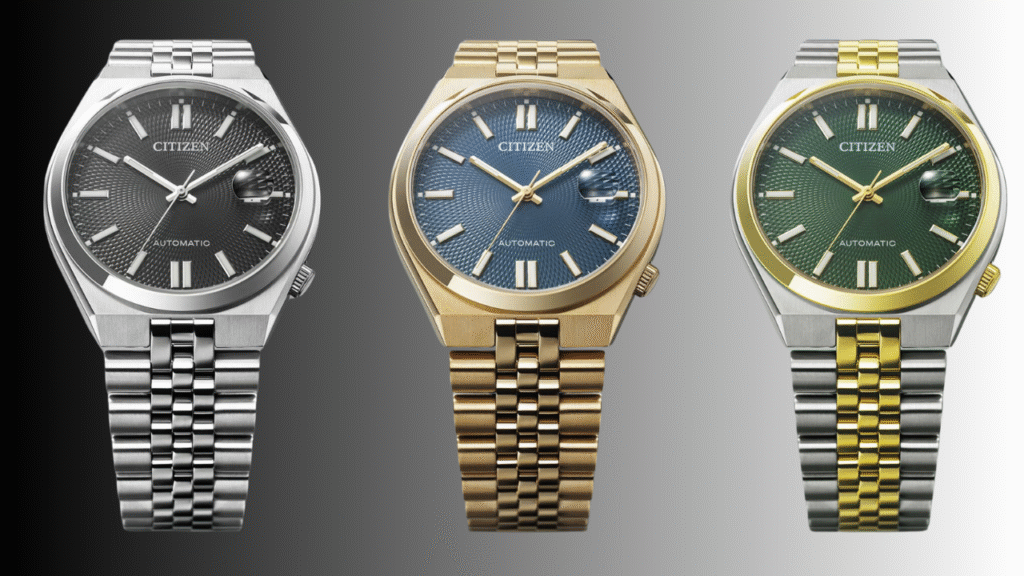
Now, Citizen builds upon this foundation with the launch of the Tsuyosa 60 Automatic. This new collection is not merely a cosmetic refresh; it represents a strategic and calculated evolution of the line. Dubbed a “more refined, more detailed, and more powerful version” of its predecessor, the Tsuyosa 60 is a direct response to a community of enthusiasts who have championed the original while offering pointed feedback for its improvement. It is a timepiece engineered to solidify the Tsuyosa’s status as a modern classic, delivering a significant upgrade in both performance and aesthetic appeal. This report will explore the key innovations of the new Tsuyosa 60, contextualize its position within the broader integrated bracelet market, and analyze why its targeted enhancements make it a formidable contender for the best entry-level automatic watch of the year.
The Tsuyosa Legacy: From Value Proposition to Market Phenomenon
The original Citizen Tsuyosa collection achieved bestseller status almost overnight, a success rooted in its ability to deliver the coveted integrated bracelet look at a price that was previously unimaginable for a quality mechanical watch. Its core appeal lay in a straightforward, yet highly effective, design. The barrel-shaped, 40 mm case with a subtle 11.7 mm thickness, paired with a half-recessed crown at 4 o’clock, provided a sleek and comfortable on-wrist presence. For a price starting at EUR 299, the watch offered a sapphire crystal, a see-through caseback, and an automatic movement with a 40-hour power reserve. This combination was a powerful draw for newcomers to the hobby, providing an accessible gateway to mechanical timekeeping without the typical financial barrier. The collection’s wide array of vibrant colors further fueled its popularity, turning it into a “go anywhere, do anything” timepiece that was both stylish and functional.
The success of the original Tsuyosa created a large and vocal community of owners and admirers. Platforms like Reddit became hubs for discussion, where users praised the watch’s comfort and design but also openly discussed its limitations. Frequent topics of conversation included the watch’s power reserve, which at 40 hours meant it would stop over a weekend if not worn or placed on a watch winder. There were also desires for more detailed dial textures and improved bracelet articulation. This collective feedback served as a critical, crowdsourced brief for Citizen’s product development team. The enhancements seen in the Tsuyosa 60 are a direct, strategic response to these community discussions. By listening to its core audience, Citizen transformed consumer feedback into a blueprint for product evolution, effectively turning a value proposition into a tailored, enthusiast-grade offering that retains its accessibility. This approach demonstrates a modern brand strategy where customer engagement directly shapes the product line, creating a deep sense of loyalty and anticipation.
Unpacking the Upgrades
The Tsuyosa 60 represents a purposeful step forward for the collection, with three primary areas of improvement that elevate its standing in the market: the movement, the dial, and the bracelet. These changes demonstrate Citizen’s commitment to moving the Tsuyosa from a “great value watch” to simply a “great watch.”
The Heartbeat: The New Caliber 8310 Movement
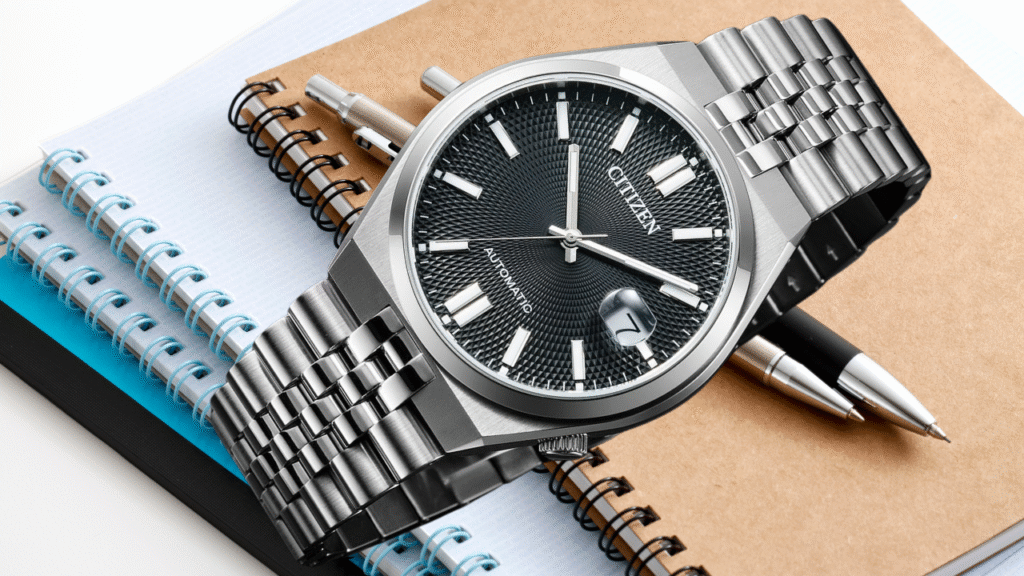
The most significant and titular upgrade is the new Caliber 8310 automatic movement, which replaces the Caliber 8210 found in the standard models. This new movement increases the power reserve by 50%, from 40 hours to a robust 60 hours. For a daily wearer, this is a transformative improvement. A 60-hour power reserve means a wearer can take the watch off on a Friday evening and it will still be ticking on Monday morning, a valuable “weekend-proof” feature that eliminates the need for frequent resetting. Beyond the increased power reserve, the Caliber 8310 also boasts improved aesthetics. The movement is better finished with silver-toned bridges and plates, an openworked rotor, and blue-colored screws that are visible through the transparent mineral glass caseback. This added visual detail appeals to enthusiasts who appreciate the mechanical artistry within the case. The movement operates at a frequency of 21,600 vibrations per hour (3 Hz), features 21 jewels, and includes a hacking seconds function, which allows for precise time-setting.
The strategic move to a 60-hour power reserve is a direct play in the competitive landscape of affordable automatic watches. Competitors like the Tissot PRX Powermatic 80 offer an even longer 80-hour reserve, and Seiko’s Caliber 6R55, found in some of its mid-tier offerings, provides 72 hours. By increasing the Tsuyosa’s power reserve to 60 hours, Citizen directly addresses a key area where its rival offerings previously held a clear advantage. This action signals an industry-wide trend where extended power reserves are becoming a baseline expectation, even in the sub-$1,000 category, as consumers prioritize enhanced convenience and reliability.
The Guilloché Dial
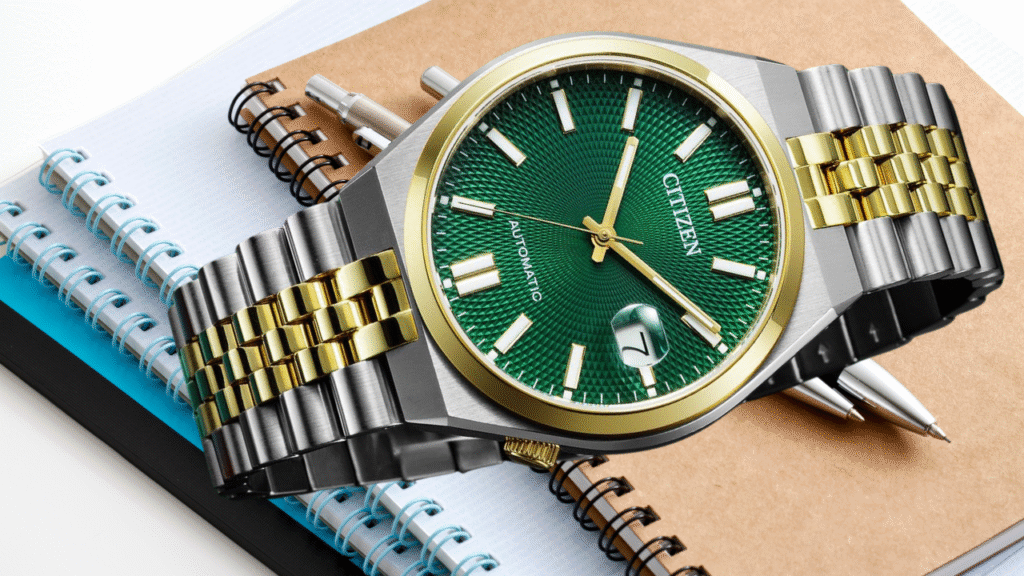
In a major aesthetic departure from the original collection’s flat, sunray dials, the Tsuyosa 60 features a stamped guilloché-like pattern. This intricate geometric texture, inspired by Art Deco design, adds significant depth and refinement to the watch, transforming its character from a sporty, utility-focused piece into a more sophisticated, dress-oriented timepiece. This intricate pattern, previously seen in the Tsuyosa Small Second, is now available across the central seconds line. The new collection offers three dial colors: a classic black on the full steel model, a trendy green on the bi-color version, and a deep blue on the full rose gold-toned variant. Each dial retains the highly legible applied luminous markers and hands, as well as the date window at 3 o’clock with a cyclops magnifier on the sapphire crystal.
The Feel on the Wrist: An Elevated Bracelet and Clasp

The Tsuyosa 60 completes its transformation with a new bracelet and clasp that further enhance its premium feel. The standard 3-link metal bracelet of the original model is replaced by a more refined 5-link, Jubilee-style bracelet. This new bracelet features a mix of brushed external links and polished central links, adding a layer of visual complexity and light play that was absent in the previous version. The bracelet is finished with a new concealed butterfly clasp, which contributes to a more integrated and seamless look on the wrist. While the integrated design offers a sleek aesthetic, it is important to note a key drawback: it prevents the wearer from easily swapping out the bracelet for different straps. For some enthusiasts, the ability to change straps is a core part of the hobby, and this limitation of the integrated design remains a point of consideration.
This table provides a clear, at-a-glance comparison of the key differences between the new Tsuyosa 60 and the original Tsuyosa model, highlighting the value of the recent upgrades.
| Feature | Citizen Tsuyosa (Original) | Citizen Tsuyosa 60 Automatic |
| Movement | Caliber 8210 | Caliber 8310 |
| Power Reserve | 40 hours | 60 hours |
| Movement Finish | Unfinished brass look | Better finished with silver-toned bridges and blue screws |
| Dial | Flat, sunray pattern | Stamped guilloché-like pattern |
| Bracelet | 3-link metal bracelet | 5-link, Jubilee-style integrated bracelet |
| Clasp | Standard folding clasp | Concealed butterfly clasp |
| Price (EUR) | EUR 299 | EUR 379 – EUR 429 |
The Integrated Bracelet Renaissance
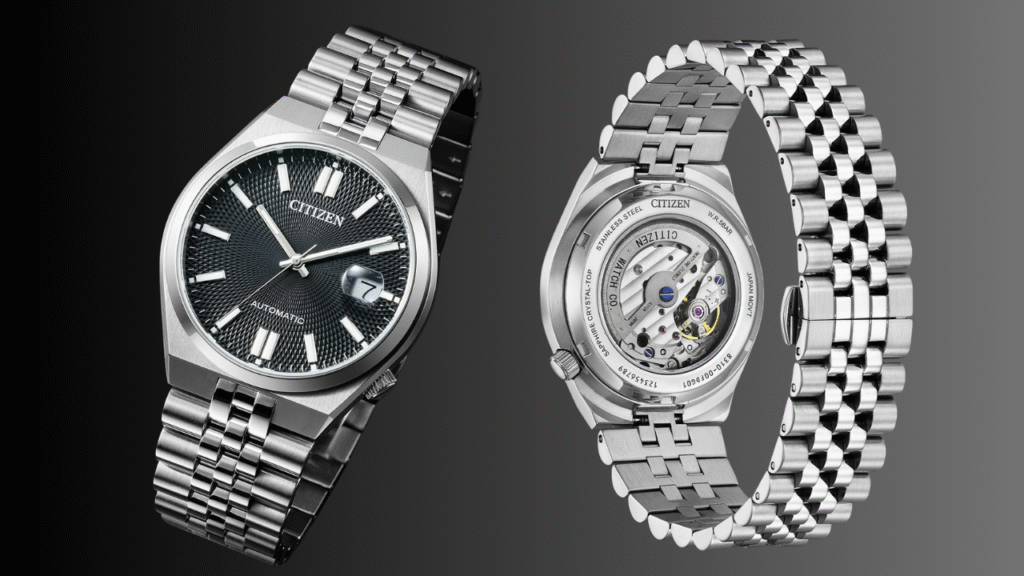
To fully appreciate the significance of the Tsuyosa 60, one must understand the rich history of the integrated bracelet sports watch. The style was largely popularized in the 1970s by Swiss designer Gérald Genta, a figure sometimes referred to as the “Picasso of watchmaking” for his distinctive and innovative designs. While integrated bracelets existed prior, it was Genta’s work that cemented the aesthetic’s place in horological history. He is credited with designing some of the most iconic watches of the era, including the Audemars Piguet Royal Oak in 1972 and the Patek Philippe Nautilus in 1976. These luxury timepieces, and others from the period like the IWC Ingenieur and the Vacheron Constantin 222, established the integrated bracelet as a symbol of high design and sport-luxury.
After a period of relative dormancy, the integrated bracelet aesthetic has experienced a powerful resurgence in recent years, with a new generation of enthusiasts drawn to its retro-futuristic charm. This revival has seen the design descend from the luxury realm to the accessible market. In this context, the Tsuyosa is Citizen’s direct and highly successful contribution to the trend. It offers the distinctive Genta-inspired aesthetic—the barrel-shaped case, the seamless bracelet integration, and the mix of polished and brushed finishes—at a fraction of the cost of its high-end predecessors and contemporaries.
The Battle for the Wrist: Tsuyosa 60 vs. Its Rivals
The Citizen Tsuyosa 60 enters a highly competitive market segment populated by other brands offering exceptional value in the integrated bracelet category. To provide a comprehensive analysis for a prospective buyer, a direct comparison with its primary rivals is essential.
The Heavyweight Contender: Tissot PRX Powermatic 80
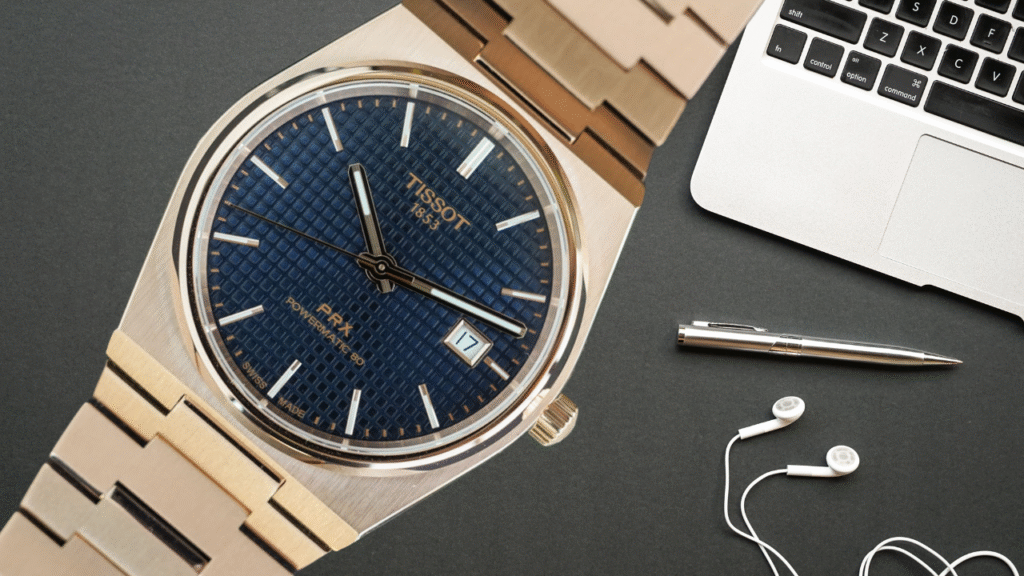
The Tissot PRX Powermatic 80 is arguably the most direct and formidable competitor to the Tsuyosa 60. It has achieved a “cult classic” status of its own, offering a compelling blend of accessible Swiss craftsmanship and vintage design. The PRX features a similarly sized 40 mm case, a waffle-pattern dial, and a robust integrated bracelet. Its key advantage has long been its movement: the Powermatic 80, which, as its name suggests, provides an impressive 80-hour power reserve. The PRX retails for significantly more than the Tsuyosa, with the automatic version priced at approximately $775, compared to the Tsuyosa 60’s starting price of around $575. With its upgraded 60-hour power reserve, the Tsuyosa 60 narrows the performance gap with the PRX while maintaining a significant price advantage, positioning it as an even more compelling value proposition.
The New Challenger: Casio Edifice EFK-100
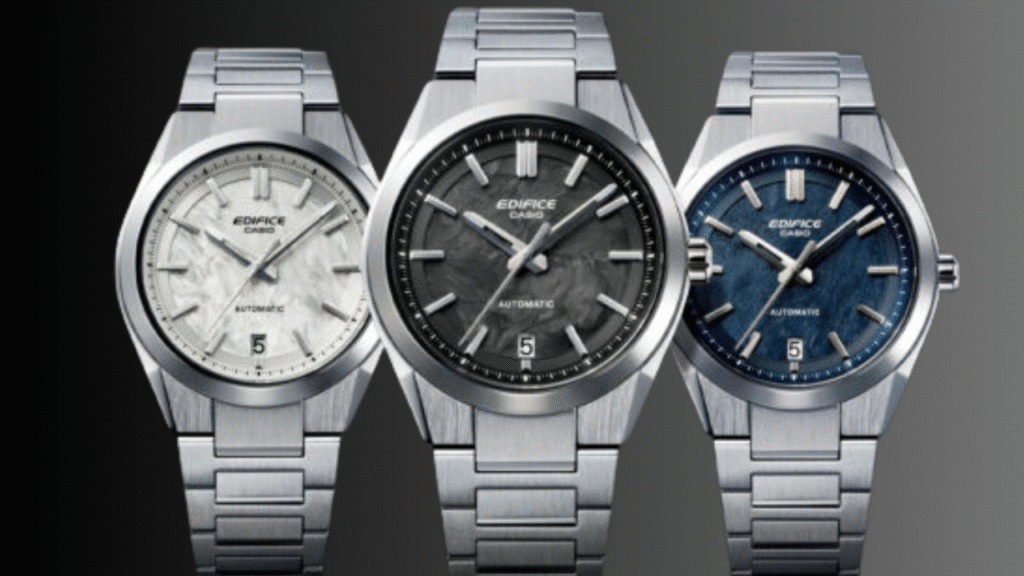
A more recent entrant into this mechanical watch segment is the Casio Edifice EFK-100. While the Tsuyosa’s design is often seen as a direct homage to classic integrated bracelet watches, the Edifice offers a more original, cohesive, and angular design that appeals to those seeking a distinct look. A technical comparison reveals important differences: the Tsuyosa 60’s Caliber 8310 provides a superior 60-hour power reserve and a better stated accuracy of −20/+40 seconds per day. In contrast, the Casio’s mechanical movement offers only a 40-hour power reserve and a wider stated accuracy range of −35/+45 seconds per day. However, the Casio holds a notable advantage in its water resistance, rated at 100 meters compared to the Tsuyosa’s 50 meters, making it a more robust option for water-based activities.
This table summarizes the competitive landscape, providing a side-by-side comparison of the key players in the entry-level integrated bracelet watch market.
| Watch Model | Key Features | Price (USD) | Power Reserve (hours) | Stated Accuracy (s/day) | Water Resistance |
| Citizen Tsuyosa 60 | Guilloché dial, Jubilee-style bracelet, improved movement | $575-$625 | 60 | −20/+40 | 50 meters |
| Tissot PRX Powermatic 80 | Waffle dial, thin case, superior Swiss movement | ~$775 | 80 | Unstated, but well-regarded | 100 meters |
| Casio Edifice EFK-100 | Original design, high WR, carbon-like dial texture | N/A | 40 | −35/+45 | 100 meters |
| Seiko 5KX GMT | GMT function, durable case, mineral crystal | $280 | 41 | Unstated | 100 meters |
Final Thought

The new Citizen Tsuyosa 60 Automatic is a well-considered and strategic evolution of an already beloved collection. The upgrades are not arbitrary additions but rather calculated responses to community feedback and market trends. By introducing a “weekend-proof” 60-hour power reserve, a sophisticated guilloché dial, and an elevated Jubilee-style bracelet with a butterfly clasp, Citizen has successfully addressed the primary areas for improvement identified by its audience. These enhancements justify the watch’s price increase and effectively narrow the performance gap with more expensive competitors while maintaining the Tsuyosa’s core identity as a leader in value.
Despite its significant improvements, the Tsuyosa 60 does carry forward one of the original’s most noted ergonomic limitations: the small, recessed crown at 4 o’clock, which some users find difficult to operate. Additionally, the integrated bracelet design, while aesthetically pleasing, removes the option for quick strap changes, a feature valued by many enthusiasts for its versatility.
Ultimately, the Tsuyosa 60 Automatic is a masterclass in product refinement. It takes the compelling foundation of the original—a comfortable case, a clean aesthetic, and an accessible price—and elevates it with meaningful, enthusiast-driven upgrades. For the newcomer seeking their first mechanical watch with a classic integrated bracelet aesthetic, or for the seasoned collector looking for an affordable yet refined daily wearer, the Tsuyosa 60 is an outstanding choice. It is a watch that not only pays homage to a timeless design but also adapts to the demands of the modern wearer, cementing its place as a quintessential modern classic and a king of the value segment.